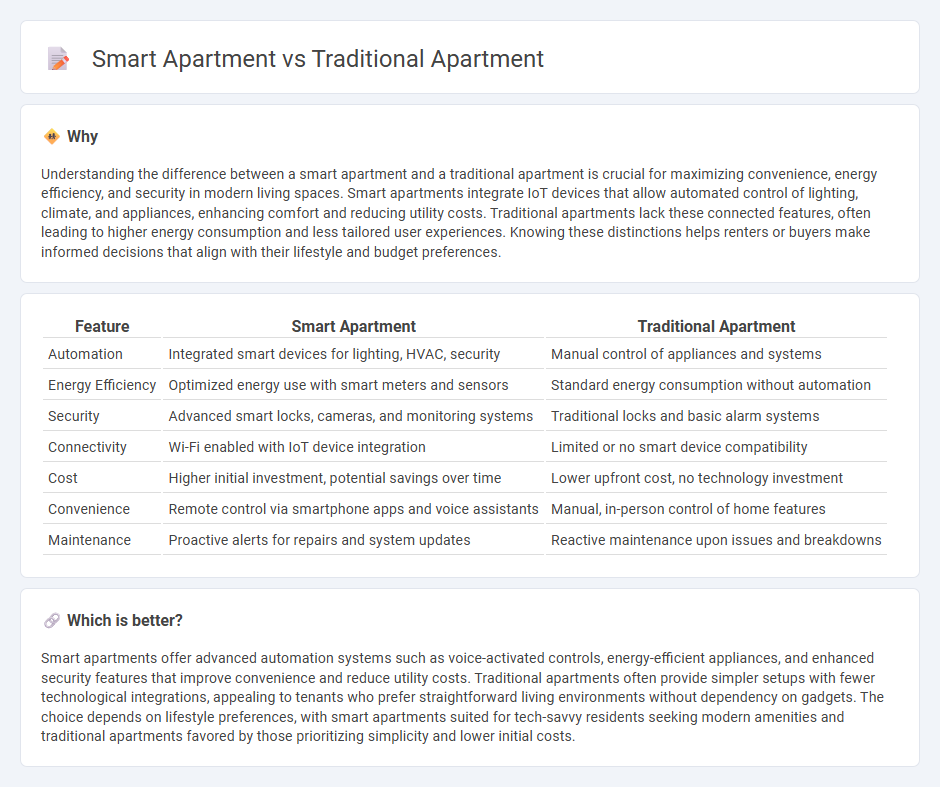
Smart apartments integrate IoT devices and automation systems for enhanced security, energy efficiency, and convenience, contrasting with traditional apartments that rely on manual controls and standard infrastructure. These intelligent living spaces offer features like remote climate control, voice-activated assistants, and smart lighting that adapt to residents' lifestyles. Discover how smart apartments are revolutionizing modern living and transforming real estate expectations.
Why it is important
Understanding the difference between a smart apartment and a traditional apartment is crucial for maximizing convenience, energy efficiency, and security in modern living spaces. Smart apartments integrate IoT devices that allow automated control of lighting, climate, and appliances, enhancing comfort and reducing utility costs. Traditional apartments lack these connected features, often leading to higher energy consumption and less tailored user experiences. Knowing these distinctions helps renters or buyers make informed decisions that align with their lifestyle and budget preferences.
Comparison Table
| Feature | Smart Apartment | Traditional Apartment |
|---|---|---|
| Automation | Integrated smart devices for lighting, HVAC, security | Manual control of appliances and systems |
| Energy Efficiency | Optimized energy use with smart meters and sensors | Standard energy consumption without automation |
| Security | Advanced smart locks, cameras, and monitoring systems | Traditional locks and basic alarm systems |
| Connectivity | Wi-Fi enabled with IoT device integration | Limited or no smart device compatibility |
| Cost | Higher initial investment, potential savings over time | Lower upfront cost, no technology investment |
| Convenience | Remote control via smartphone apps and voice assistants | Manual, in-person control of home features |
| Maintenance | Proactive alerts for repairs and system updates | Reactive maintenance upon issues and breakdowns |
Which is better?
Smart apartments offer advanced automation systems such as voice-activated controls, energy-efficient appliances, and enhanced security features that improve convenience and reduce utility costs. Traditional apartments often provide simpler setups with fewer technological integrations, appealing to tenants who prefer straightforward living environments without dependency on gadgets. The choice depends on lifestyle preferences, with smart apartments suited for tech-savvy residents seeking modern amenities and traditional apartments favored by those prioritizing simplicity and lower initial costs.
Connection
Smart apartments integrate advanced IoT technology, enhancing traditional apartment living by automating lighting, climate control, and security systems. These interconnected devices optimize energy efficiency and provide residents with seamless control through mobile apps. As a result, traditional apartments transform into smart homes, offering increased convenience and improved living standards.
Key Terms
Manual Utilities
Traditional apartments rely heavily on manual utilities management, requiring residents to adjust heating, lighting, and water usage individually, which can lead to inefficiencies and higher costs. Smart apartments utilize automated systems and IoT devices to optimize energy consumption, allowing remote control and real-time monitoring of utilities for improved convenience and sustainability. Discover how upgrading to a smart apartment can transform your living experience by enhancing comfort and reducing expenses.
Smart Home Automation
Smart apartments leverage advanced home automation systems that allow remote control of lighting, climate, security, and appliances via smartphones or voice commands, enhancing convenience and energy efficiency. Unlike traditional apartments, they integrate IoT devices to provide real-time data and personalized living experiences tailored to occupant preferences. Explore how smart home automation transforms everyday living for enhanced comfort and sustainability.
Remote Monitoring
Traditional apartments rely on manual inspections and physical security measures, limiting real-time awareness of property conditions. Smart apartments utilize IoT sensors and connected devices for continuous remote monitoring, enabling instant alerts for security breaches, maintenance issues, and energy usage. Explore how remote monitoring in smart apartments revolutionizes convenience, safety, and efficiency for modern living.
Source and External Links
Apartment - An apartment is a self-contained housing unit that occupies part of a building, often on a single story, and is a type of residential real estate.
Traditional Apartment Processes - Vanderbilt University offers various apartment options for students, including 6-person, 4-person, 3-person, and 2-person apartments with shared bedrooms and amenities like full kitchens.
Traditional Apartment Exterior Ideas - Houzz provides a collection of traditional apartment exterior design ideas, offering architectural inspiration for home decor and facade enhancement.
 dowidth.com
dowidth.com